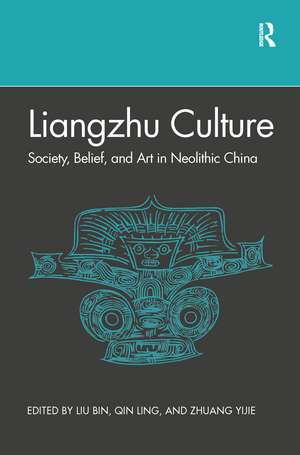Liangzhu Culture: Society, Belief, and Art in Neolithic China
Editat de Bin Liu Traducere de Yijie Zhuang Editat de Ling Qinen Limba Engleză Paperback – 30 iun 2021
Liangzhu Culture contextualises Liangzhu in broad socio-economic and cultural backgrounds and provides new, first-hand data to help explain the development and structure of this early urban centre. Among its many insights, the volume reveals how elites used jade as a means of acquiring social power, and how Liangzhu and its centre stand in comparison to other prehistoric urban centres in the world.
This book, the first of its kind published in the English language, will be a useful guide to students at all levels interested in the material culture and social structures of prehistoric China and beyond.
| Toate formatele și edițiile | Preț | Express |
|---|---|---|
| Paperback (1) | 389.66 lei 6-8 săpt. | |
| Taylor & Francis – 30 iun 2021 | 389.66 lei 6-8 săpt. | |
| Hardback (1) | 767.57 lei 6-8 săpt. | |
| Taylor & Francis – 27 noi 2019 | 767.57 lei 6-8 săpt. |
Preț: 389.66 lei
Nou
Puncte Express: 584
Preț estimativ în valută:
74.56€ • 78.05$ • 62.06£
74.56€ • 78.05$ • 62.06£
Carte tipărită la comandă
Livrare economică 31 martie-14 aprilie
Preluare comenzi: 021 569.72.76
Specificații
ISBN-13: 9781032084831
ISBN-10: 1032084839
Pagini: 258
Ilustrații: 163 Illustrations, black and white
Dimensiuni: 156 x 234 x 14 mm
Greutate: 0.45 kg
Ediția:1
Editura: Taylor & Francis
Colecția Routledge
Locul publicării:Oxford, United Kingdom
ISBN-10: 1032084839
Pagini: 258
Ilustrații: 163 Illustrations, black and white
Dimensiuni: 156 x 234 x 14 mm
Greutate: 0.45 kg
Ediția:1
Editura: Taylor & Francis
Colecția Routledge
Locul publicării:Oxford, United Kingdom
Cuprins
Figures; Contributors; Acknowledgments; Preface; Chapter One: Situating the Liangzhu Culture in Late Neolithic China: An Introduction; Chapter Two: The Liangzhu City: New Discoveries and Research; Chapter Three: Power and Belief: Reading the Liangzhu Jade and Society; Chapter Four: A Controlled Fine Craft: Jade Production Techniques in the Liangzhu Culture; Chapter Five: From the ‘Songze Style’ to the ‘Liangzhu Mode’; Chapter Six: Shamanistic, Historic and Virtuous Jade: Continuity and Change in Early Chinese Jade Traditions; Glossary; List of Historical Records; Bibliography; Index
Notă biografică
Liu Bin is Professor and Director of Zhejiang Provincial Institute of Cultural Relics and Archaeology. He has joined or directed excavations at the Fanshan, Yaoshan, Huiguanshan, and Nanhebang sites, and the Liangzhu City since 1985. His main research interests include the prehistory of the Lower Yangtze River and the archaeology of jade.
Qin Ling is Associate Professor of Neolithic Archaeology and Archaeobotany at the School of Archaeology and Museology, Peking University, Beijing. Her research interests include scientific research on Neolithic jades in Eastern China, early agricultural developments in the Lower Yangtze River and Southwest China, and comparative perspective on civilisational discourses across East Asia.
Zhuang Yijie is Associate Professor in Chinese Archaeology at the Institute of Archaeology, University College London. He applies geoarchaeological approaches to reconstruct ecologies of early agriculture and long-term land use changes in East, South and Southeast Asia. He is also interested in the comparison of diverse trajectories to social complexity in these regions.
Qin Ling is Associate Professor of Neolithic Archaeology and Archaeobotany at the School of Archaeology and Museology, Peking University, Beijing. Her research interests include scientific research on Neolithic jades in Eastern China, early agricultural developments in the Lower Yangtze River and Southwest China, and comparative perspective on civilisational discourses across East Asia.
Zhuang Yijie is Associate Professor in Chinese Archaeology at the Institute of Archaeology, University College London. He applies geoarchaeological approaches to reconstruct ecologies of early agriculture and long-term land use changes in East, South and Southeast Asia. He is also interested in the comparison of diverse trajectories to social complexity in these regions.
Descriere
Liangzhu Culture comprises a valuable set of contributions on materiality and jade production in the context of the Liangzhu culture of the Lower Yangzi River valley. It details the important finds and research from the Liangzhu site and the Liangzhu culture making this important data available to an audience outside of China
